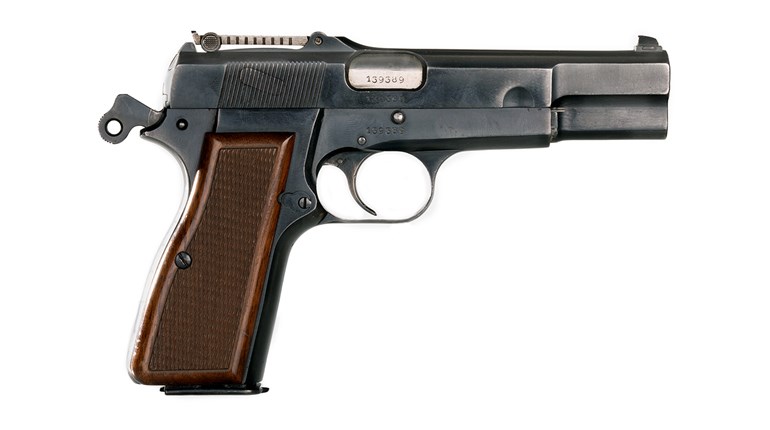
In 1953, former Royal Naval Volunteer Reserve Lieutenant Commander Ian Fleming published the first of his 12 novels featuring the master spy James Bond. With 1962’s “Dr. No,” the first of an eventual 26 Bond films, Hollywood launched a series of copycat films designed for capturing the fantasy spy market with films such as “Our Man Flint” (1966) starring James Coburn, and Dean Martin’s spy comedies as Matt Helm.
It was Karl Malden’s character—Julian Wall—in “Murder’s Row” (1966), the second Matt Helm film, that shocked audiences when he used an odd-looking handgun equipped with a rocket-propelled spear. It was the first time a Gyrojet had a scene on screen, and it would be one of only a surprisingly few appearances.
In 1960, Robert Mainhardt and Art Biehl, two engineers in San Ramon, CA, began to develop a rocket-propelled projectile small enough to be fired from a handheld firearm. They formed MB Associates and set up a manufacturing firm to produce what would be marketed as the Gyrojet, a.k.a. Rocketeer, handguns and carbines that fired a solid-fuel rocket projectile.
The Gyrojet hit the market in 1965 with reviews in numerous gun magazines that heralded it as the gun of the future. Rocket-propelled projectiles were not really all that cutting edge in 1965—the “rocket’s red glare” of our national anthem was written by Francis Scott Key in 1814, describing the attack on Fort McHenry. They were used during the Mexican-American War in 1847 and in the Crimea in 1856. But, condensing the rocket into a size small enough for anti-personnel use was something definitely encouraged by the space age that coincided with the Cold War.
The Gyrojet was a lightweight, smoothbore pistol made of Zamac, a zinc-aluminum alloy. It resembled the shape of a conventional .45 ACP 1911 and held six, solid-rocket-fuel cartridges in the grip of the pistol. The projectile was not the only unique feature of the gun: The round was chambered and held in place by a hammer that struck the nose of the bullet to ignite the fuel propellent.
The ignition was fairly slow at the start, with the round moving down the smoothbore barrel and gaining velocity as it went forward. Eventually, it would reach 1,200 fps, breaking Mach 1. One early photo of the gun being demonstrated in a boardroom environment showed it being fired with the muzzle in contact with a glass-top table. The round accelerated to the muzzle but did not have enough energy to break the glass—it only continued to spin at the muzzle until the propellant expended itself. It would not reach maximum velocity until it was approximately 60 feet downrange.
The Gyrojet round itself was the design of Nick Minchakievich, who worked with MB Associates to develop the angled ports in the base of the cartridge that gave the projectile its spin, eliminating the need for rifling that would have been redundant, especially considering the round would not generate enough initial chamber pressure to grip any rifling. Some early models had offset ports in the barrel that caused the rounds to “corkscrew” in flight, but this was soon fixed with matching ports that allowed the round to leave the muzzle on target.

Most reviewers who have fired the Gyrojet, myself included, found it to have nearly zero recoil, and it is fairly accurate to about 50 feet. It is challenging to load and chamber a round, and the original Gyrojets came with quite the detailed owner’s manual. Pretty much everything about the gun is counterintuitive, especially if you are used to handling normal semi-automatic firearms.
The first review I was able to find was in Guns & Hunting magazine’s November 1965 issue. Paul B. Weston’s article stated that the guns, when released to the public, would cost slightly less than $100 and a box of ammunition would be about $7, comparable to a box of .45 ACP at the time. The same issue of the magazine carried an ad from Klein’s Sporting Goods offering M1 Garands for $84.95 and M1 Carbines for $59.95 to give you an idea of what the comparable value of collectible firearms was at the time.
The 1969 Edition of the reference guide “Shooter’s Bible” listed the Mark I as weighing in at 13 ounces and selling for $160, while the limited-edition, presentation-cased Mark 1 sold for $250 and included a bronze coin honoring Robert Goddard, the father of American rocketry. A package containing two dozen 13 mm rounds was listed at $31.20. While many considered this a novelty gun, it was priced out of reach for most ordinary shooters. The carbine version sold for $300.
The gun, even with the assistance of aerospace legend Wernher von Braun, never received serious interest from the U.S. military. Its chambering in 13 mm limited its availability to the commercial marketplace following the passage of the 1968 Gun Control Act, which classified anything that had a diameter greater than .50 inch as a Destructive Device (13 mm translates into approximately .51-caliber). Reconfigured in 12 mm (.47-caliber) for domestic sales, the gun saw limited commercial success, and it is estimated that only slightly more than 1,000 pistols and carbines were made during its short lifespan.
Today, Gyrojets bring in excess of $2,000 at auction, and the cartridges routinely cost $200 each. Despite its early publicity as the gun of the future, it is now, sadly, a curiosity—and an expensive one at that.




































